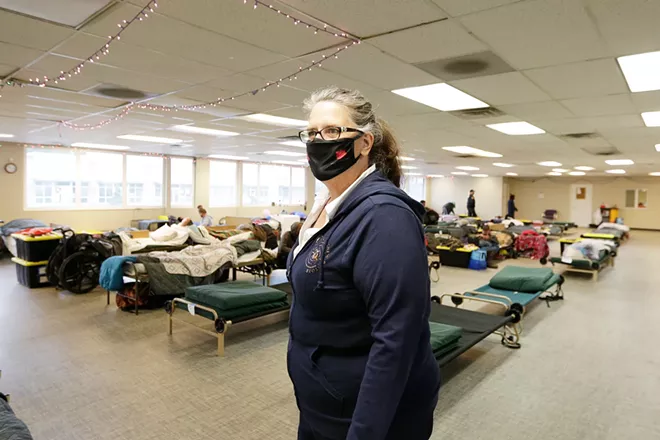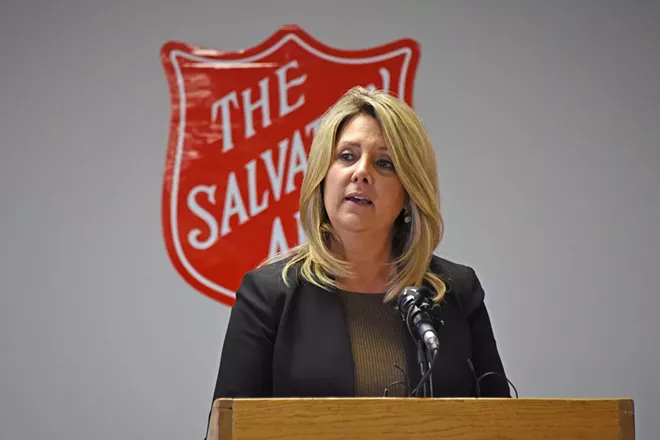
On Friday, Spokane Mayor Nadine Woodward and elected leaders from across the region gathered inside what was, until recently, an emergency homeless shelter. With a big smile, Woodward cut the ribbon signifying its transformation into the "Way Out Center," run by the Salvation Army.
The former shelter on Mission Avenue was turned into a "bridge housing" program meant to provide a "measure of accountability" along with "compassionate support" in order to help people out of homelessness, Woodward says. It's referral-based and will provide housing, employment, addiction, behavioral health and other services to help up to 60 people at a time out of homelessness.
For Woodward, it was the kind of solution for homelessness she campaigned on.
"It's not just a program. It's not just a shelter," Woodward said at the ceremony. "It is a path to becoming self-sufficient."
But while City Council President Breean Beggs and City Council member Betsy Wilkerson clapped along in support, they remain concerned with the city's immediate plan for emergency shelter this winter. Turning the Way Out Center into a high-barrier program means the city is losing the former shelter's 100 low-barrier beds, which don't require sobriety, that may be needed this winter.
Despite the city adding other permanent low-barrier shelter space in recent months, shelters for women and families are already having to turn people away. Joe Ader, executive director of Family Promise, says Open Doors emergency shelter is turning away "100 people per month." Hope House, the downtown women's shelter run by Volunteers of America, is rejecting dozens of women each week, primarily due to staffing shortages at the shelter.
It's why, just the day before the ribbon-cutting ceremony, council members grilled city staff over shelter space in the immediate future. And they didn't appear satisfied with the answers.
"I know we've got a long-term plan, but we need a short-term plan, and we are waiting to hear what that looks like," Wilkerson says.
The last-minute scramble to find shelter space in the winter has been a recurring issue each of the last several years.
In past years, the city has opened temporary pop-up warming centers to at least get people off the streets during cold winter nights. But this year, city officials don't have any immediate plans to open more warming centers.
Instead, city spokesperson Brian Coddington says the city focused on turning previous warming center spaces into more-permanent shelters, with the goal of providing more stability and consistency in the shelter system. Making these shelters permanent, Coddington says, should also make it easier for shelter providers to hire staff.
For example, in the past, the Truth Ministries shelter has contracted with the city only in the winter months for low-barrier space. Now, the city has finalized a contract with Truth Ministries for those beds to be available year-round.
"Those are in place now and have been in place for a couple of months," Coddington says. "There's no need to have a weather-dependent purchase of those beds. Those are there."
The city also finalized a year-round contract with the Guardians Foundation to run an emergency shelter on Cannon Street. That location, too, was run as a temporary shelter space until recently.
Additionally, Volunteers of America and Transitions have together opened 30 new beds specifically for young adults.
But those permanent shelter spaces still fall short of the overall number of low-barrier beds available last winter. The city put out a request for proposals for flexible surge capacity at shelters last week, but that process will take several weeks. Mayor Woodward included dollars for another low-barrier shelter in her budget proposal for next year, but that wouldn't solve the immediate need for shelter either.
"We're going to need more pop-up facilities throughout the winter for sure," Ader says. "And there is currently not a solid plan in place."
Coddington, however, says that the city does have a plan to manage overflow of shelters. If there is no space, the city will continue its hotel voucher program, which puts people experiencing homelessness in hotels or motels temporarily. The city has used COVID relief money to pay for the vouchers.
Ader says that's a solution for some individuals, but it's expensive and can be difficult for large families, since there are so many people in a small hotel room.
"Hotels are really designed for travelers and one-night stays, not for folks long-term," Ader says.
"I expect hundreds of families to become homeless. And Spokane is not equipped to handle the homeless population. There is not enough room."
Still, the hotel vouchers worked well enough for Gina Jose, a 38-year-old mother of four kids who became homeless in February.
Her landlord said her kids, three of whom have serious behavioral health issues, were causing damage to the property and were a safety risk — a way around the eviction moratorium. And for Jose, finding another apartment was impossible with Spokane's minuscule vacancy rate.
"There was literally nothing available," Jose says. "The places that were available were more than $2,000 a month."
Without a home, the family stayed at the Open Doors shelter run by Family Promise. Then, with the shelter full and dealing with COVID-19 outbreaks, Jose and her kids stayed in a hotel downtown, paid for with the city's COVID relief funds, until September when they finally got their own apartment.
Jose says she preferred to stay in a hotel with her kids instead of a shelter. But with the eviction moratorium expiring, she — like shelter providers and homeless advocates — fears what might happen with an influx of family homelessness.
"I expect hundreds of families to become homeless," Jose says. "And Spokane is not equipped to handle the homeless population. There is not enough room."
Compounding the problem is that staffing challenges are forcing existing shelters to reduce capacity.
Last week, Hope House had a capacity of 80 beds but staff for only 40 to 50 beds, says Fawn Schott, president and CEO of Volunteers of America Eastern Washington.
"It breaks my team's heart to have empty beds in the shelter," Schott says. "We didn't build a shelter to have empty beds. It's incredibly painful to do that. But I can't risk the safety of my staff to have one or two people with 80 women."
During the meeting, Council member Karen Stratton expressed disappointment that neither Woodward nor City Administrator Johnnie Perkins were there to explain the plan, calling their absence "the elephant in the room."
"If we go to sleep next Monday, and temperatures drop below zero," Stratton says, "we'll wake up and start answering phone calls from people on the streets, unable to find beds." ♦

